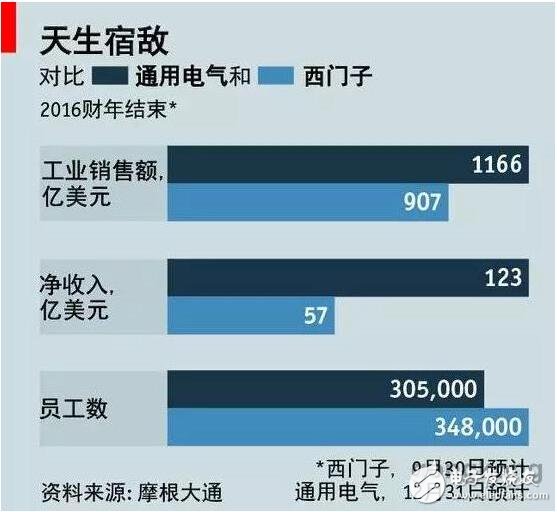A few days ago, an article entitled "GE, Siemens market overlap rate of up to 70% who will lead the Internet of Things era?" caused an onlooker. Now, the two industrial giants are carrying out the most profound changes in the history of the company – from machine builders to digital companies. US industrial giant General Electric has made a big leap into the Internet of Things, and its important competitor, Siemens in Germany, has adopted a more cautious approach. The 70% overlap indicates that the situation of the two companies grabbing a market cake may increase. So, who wins and who loses?
Both are industrial giants, with two annual revenues of $100 billion, the world's two largest diversified industrial groups; according to data from JPMorgan Chase Bank, GE and Siemens have a market overlap rate of 70%.
Despite being a diversified industrial group, GE and Siemens vary greatly from product to corporate culture. If you use the four-character idiom to describe: GE is "the heroic dry cloud", on the contrary, Siemens is "small and cautious."
From the point of view of selling products: GE mainly sells large single-piece products, such as jet engines and locomotives; Siemens has performed better in product design and factory automation.
From the perspective of organizational structure: GE belongs to the "centralized faction", the department is more concentrated, and has the strength of a large company, but it is as fast and flexible as a small company; Siemens belongs to the "separate school", the department is more dispersed, and the centers are mutually Competition, competition for status.
From the perspective of corporate culture: GE is a typical "American style": open, resolute and vigorous; Siemens is "stereo": rigorous and conservative, pay attention to argumentation, process (but the result of careful decision-making is not always good: Siemens The profit is only half of GE's).
So it's no surprise that the two companies have taken a different approach to digitalization. GE is revolutionizing, and Siemens has chosen to stick to its roots and make small changes. However, the reasons for the radical reform of Siemens and GE are not only the huge potential benefits of data, but also the threat of digitization: if manufacturers can't meet the needs of customers to change machines and reduce maintenance costs, there is always competition. The opponent will do this. Then at this time, not two people compete, but multiple people compete. So, what do they do in the “three-step†of the digital transformation of the two?

1. Build an open manufacturing "platform"
General Electric: Since 2011, it has invested billions of dollars in Predix's data platform, which will install a variety of industrial "applications" to manage wind turbines and locomotive marshalling. General Electric has set Predix as an "open" platform, not limited to GE's own machines or applications. For example, Pitney Bowes, which manufactures heavy-duty postal systems and products, also uses the platform to analyze the data collected by its machines to improve management. At the same time, GE is also using Predix to transform the company's internal organizational structure. For example, GE has set up a separate software company in San Ramon near Silicon Valley to develop Predix.
CAT5E Keystone Jack is an integral parts of RJ45 networking connectors for speed voice, video, data server center, CAT5E keystone jacks are an integral part of any high speed voice, data, or video network. These standardized female connectors are used for inserting multi-conductor Ethernet cable into wall plates, patch panels, or surface mount boxes. The Uonicore offer excellent value and selection with our line of keystone jacks including: MIG+, shielded, high density, tool-less, and snap-in styles
CAT5E Keystone Jack,UTP CAT5E Keystone Jack,Keystone Jack CAT5E,Cat5e Jack
NINGBO UONICORE ELECTRONICS CO., LTD , https://www.uonicore.com